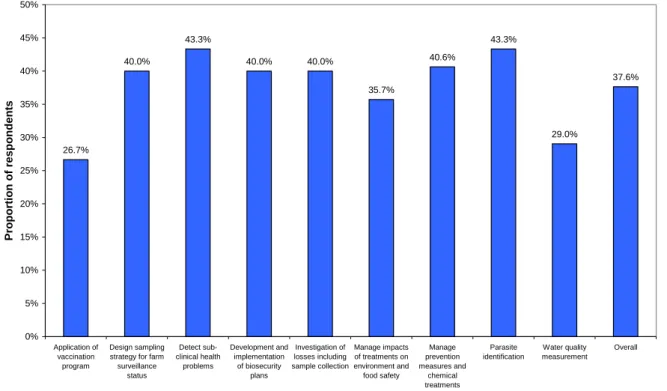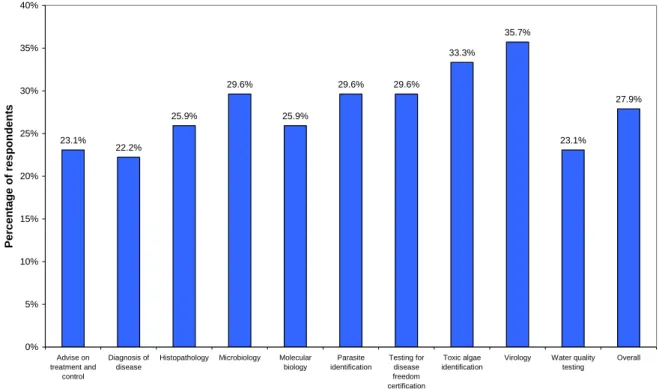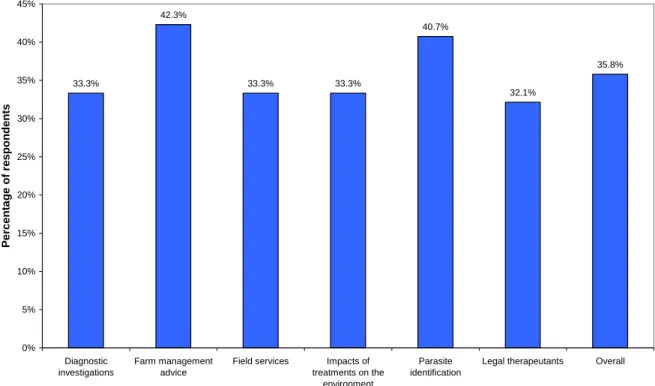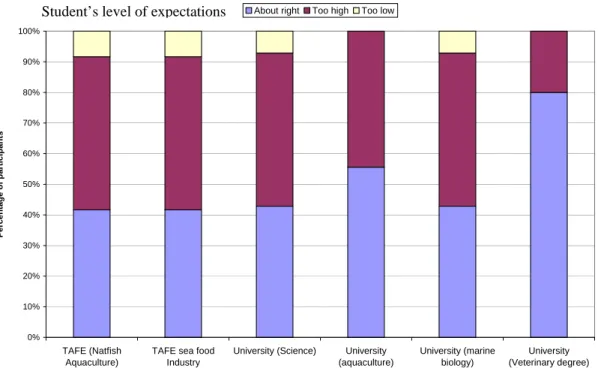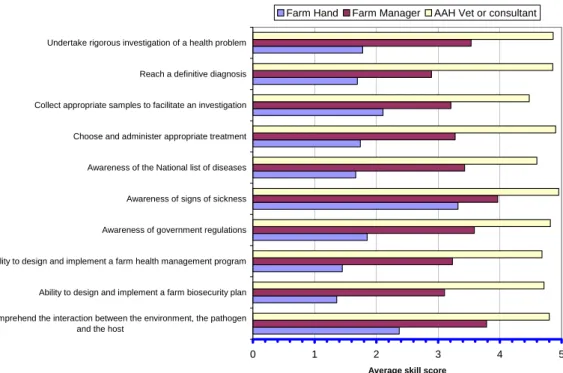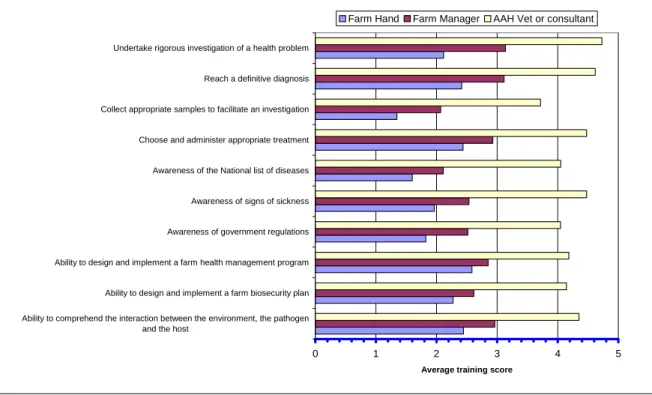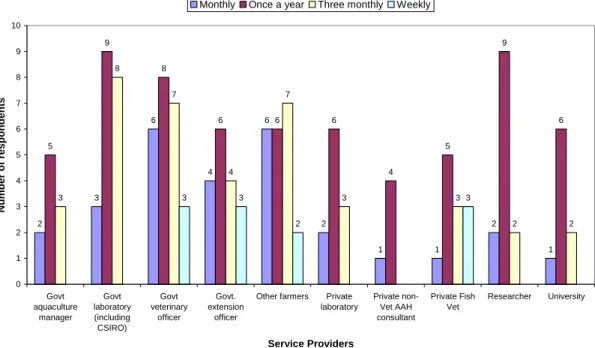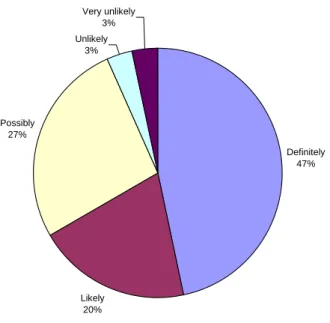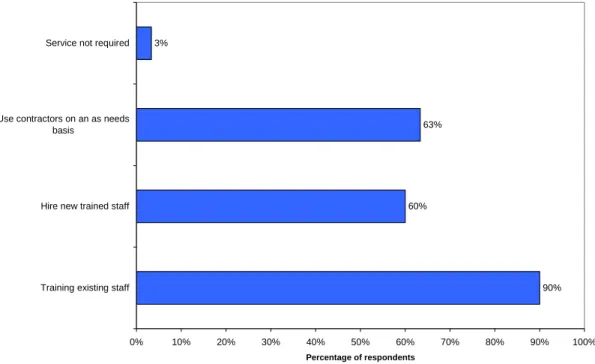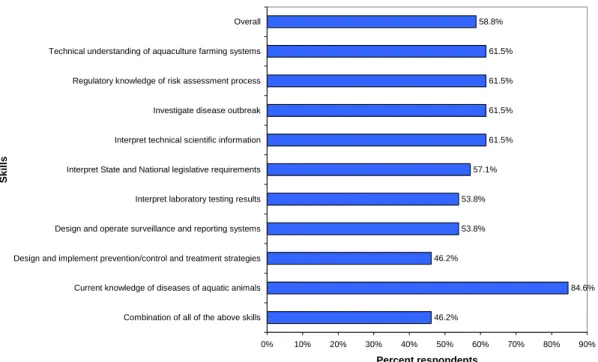Title: Aquatic animal health Sub-programme: Current and future needs for aquatic animal health training and merit-based accreditation and competency assessment systems. Aquatic Animal Health Subprogram: Current and future needs for aquatic animal health training and merit-based systems.
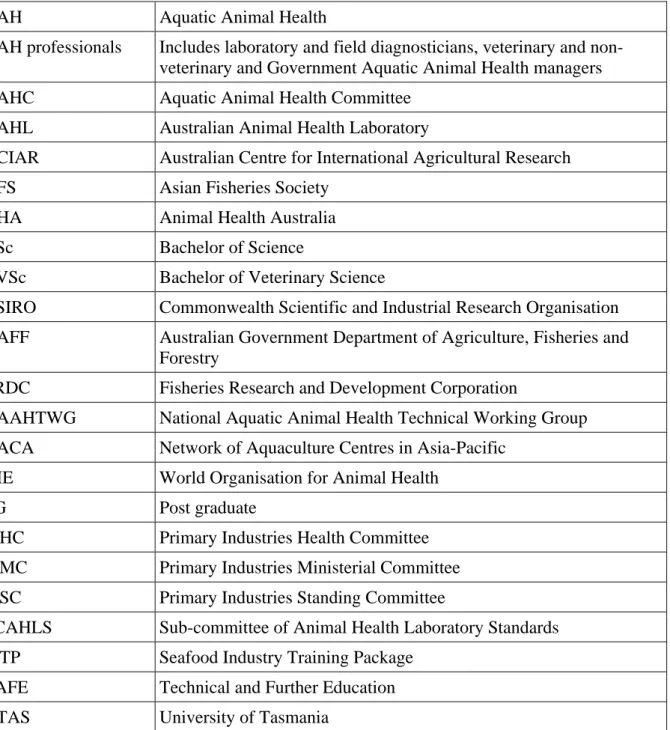
That Australian universities be encouraged to incorporate a greater component of aquatic animal health into undergraduate training courses, through the
That funding be sourced to support traineeships in aquatic animal pathology at Government and University Aquatic Animal Health Laboratories around Australia
That Australian college of veterinary science approach providers to assess potential for endorsed graduates of tertiary undergraduate degree programs to undertake a
That State Governments be asked to subsidise the cost of investigations of novel aquatic animal disease outbreaks, to underpin development of improved
That nationally funded research projects with AAH components should include links to a Veterinary school, a State Government AAH diagnostic laboratory and
Aquaculture stakeholders' expectations of the level of aquatic animal health knowledge their farm workers need to perform optimally in the respective activities. Aquaculture stakeholders' expectations of the level of aquatic animal health knowledge they (farm managers) need to perform optimally in the respective activities. Aquaculture stakeholder expectations of the level of aquatic animal health knowledge required by diagnostic laboratory employees to perform optimally in the respective activities.

Low level of understanding of the training depth required to instil high level skills to deliver competent AAH services
Limited use of AAH professional services
Depth and breadth of training within individual under-graduate qualifications is sub-optimal to meet industry and Government needs
Low understanding of the depth of training required to impart high-level skills to deliver competent AAH services. Through personal and telephone conversations, the consultant discovered that there was a lack of awareness about the depth of general animal health training provided within the BVSc bachelor's programs by graduates of the bachelor's programs (see Figure 85). Recently, veterinary schools have begun to respond to the demand for training in aquatic animal health by expanding bachelor's degree programs.
A process for this was proposed through the development of the National Aquatic Animal Health Curriculum. Five out of six institutions stated that the creation of such curricular material would be beneficial. In addition, all six indicated that they would be willing to use curriculum materials developed by another institution.
Again, all six said they would be willing to assist in the development of such material, and five out of six suggested they would be willing to share the services of a veterinary academic (see Figure 86). No post-graduate opportunities in Australia to provide high-level specific education and training in aquatic animal health.
No post-graduate opportunities in Australia to provide specific high level education and training in aquatic animal health
The study of educational institutions' undergraduate curricula identified veterinary graduates offered a deep understanding of the general principles of disease, but their specific knowledge regarding aquatic animals would be significantly lower than that of graduates with biology/aquaculture degrees (see Figure 84). Conversely, BSc Aquaculture graduates, although exposed to a significant amount of specific AAH training, do not gain a similarly deep understanding of disease principles. Some key gaps in the BVSc degree relate specifically to material on invertebrates, crustaceans and aquaculture systems and their management.
The main shortcoming in the BSc and Aquaculture courses is the lack of content in general disease principles, pathophysiology and epidemiology. There is clearly a need for veterinary and BSc Aquaculture institutions to work more closely as proposed in the recommendations of this report. Only 11% of laboratory respondents felt that there was sufficient training, of a sufficient standard, available to facilitate their training (see Figure 57).
Greater practical training for undergraduate and postgraduate students is needed. Aquaculture stakeholders commented to the consultant on the need for AAH.
Greater hands-on training for undergraduates and post-graduates needed Aquaculture stakeholders made comment to the consultant of the need for AAH
Current expectations of laboratories exceed their capacity to deliver due to lack AAH professionals in field
These expectations are beyond the scope of a routine veterinary diagnostic laboratory and are inconsistent with all other animal health provisions in Australia. Only 11% of laboratory staff felt that they could always send their report to someone who was well equipped to interpret it and develop a field action plan in response to the laboratory findings (see Figure 51). Again this is a striking contrast to the terrestrial animal production industries where the vast majority of the samples are.
The veterinarian generates a treatment and prevention program on the farm, with full knowledge of the livestock situation. Implementation of the recommendations for improving university training will go towards correcting this area of deficiency.
Loss of traditional training avenues
Increasing demand for AAH services over the next 5-10 years
Unfortunately, there appears to be an insufficient supply of adequately trained veterinarians to meet all of the industry's needs in some geographic areas of Australia, as shown by farmers' comments in interviews. Where farmers were able to access treatment advice from government veterinarians, this was generally considered very favourable, with the highest average rating of all service providers (see Figure 18). Implementation of the recommendations to improve undergraduate education will move towards correcting this shortcoming. government and private) by farmers have contributed to the formation of a culture, where farmers attempt to deal with their health problems internally (see Figure 16) or to seek help from state government laboratories or a state veterinarian where available.
Only 20% of industry respondents indicated that they rely on private veterinary or private non-veterinary AAH professionals for their AAH needs. For more than 53% of those who use private services, this only happens once a year, compared to more than 65% who use public services, largely through state government. This perhaps indicates the need for greater marketing of the services available and their value to the industry.
Improving the culture of the aquaculture sector to engage AAH professionals can be facilitated by the educational improvements suggested in the recommendations for the connections between research, veterinary schools and diagnostic laboratories. The trend of state government resources away from industry development and toward regulation and compliance threatens the development of AAH.
State Government resource trend away from industry development and towards regulation and compliance threatens AAH development
The Commonwealth consults with the same professionals through the NAAH-TWG Committee, although this is not the only source of AAH service used by the Commonwealth. Some expressed concern that there was a real risk in the short term. It is crucial for the quality of results that highly qualified individuals remain available to perform these key functions.
This makes it necessary to apply the recommendations of this report to ensure that appropriately skilled staff continue to be created. State government jobs and internship opportunities should be available for suitably qualified people, to ensure that biosecurity and AAH policy keep pace with international best practices, while promoting aquaculture growth and protecting fishery resources. Time within government positions should be allocated for self-study to promote continued learning in this rapidly evolving field.
This mechanism is also important to ensure an efficient continuity of intellectual property, as many highly skilled senior fish pathologists are approaching retirement. Successful examples of health management in Australia's terrestrial primary production industries and Tasmania's salmonid industry should be followed, to require greater engagement of AAH professionals in the aquaculture and fishing industries.
The role of the Australian College of Veterinary Scientists in continuing education of veterinarians
A competency standard is provided for veterinarians who have worked in the AAH field through the Australian College of Veterinary Scientists' membership survey in aquatic animal health. The summary and recommendations will be sent to the Animal Health Committee once the NAAH-TWG has had the opportunity to comment on them. Due to the great commonalities between the problems of providing AAH services to the provision of animal health services more generally, it is suggested that the paper is also presented to AHC.
If implemented, the recommendations will in the longer term provide some assurance of the quality and continuity of AAH service provision to aquatic animal industries. The recommendations will provide training pathways to create highly qualified aquatic animal health professionals to deliver improved health outcomes for aquaculture and other aquatic animal stakeholder industries, including government. Improved aquatic animal health services will result in more profitable, reliable production in aquaculture and improved surveillance capacity for Australia to maintain its favorable disease status.
That Australian universities be encouraged to incorporate a greater component of aquatic animal health into undergraduate education courses, through aquatic animal health in undergraduate education courses. This funding is to be raised to support internships in fish pathology at government and university aquatic animal health laboratories around Australia.
That funding be sourced to support traineeships in fish pathology at Government and University aquatic animal health laboratories around Australia
That Australian universities are encouraged to develop postgraduate training opportunities with formal international links, e.g.
That AAHC approach providers to assess potential for endorsed graduates of tertiary undergraduate degree programs to undertake a program of mentoring,
That nationally funded research projects with AAH components should include links to a veterinary school, a State Government AAH diagnostic laboratory and
Training in the diagnostic pathology of aquatic animal health is required to be included in nationally funded aquatic animal research projects. Aquatic Animal Health Knowledge Level Activity Not required Basic understanding used occasionally Basic understanding used regularly Advanced understanding used occasionally Advanced understanding used regularly. Tick each box with an "X" and the training (eg UTAS, Flinders, Deakin, Spencer TAFE, Natfish etc.) Source of Aquatic Animal Health Education and Training Operator Level TAFE On-the-job Training (including Training Package Seafood Industry) University.
Use contractors as needed. Service not required. minimum competency/accreditation standard brought into the areas of AAH services that your industry advises on Aquatic Animal Health, Laboratory Services). CSIRO) Private Laboratory Staff Private Veterinary Consultant Private Aquatic Animal Health Consultant Other (specify) ore AAH skills and services into your management structure. Yes No Only in some areas (specify missing) for regular submitters of aquatic animal diagnostic samples.
CSIRO) Private Veterinary Consultant Private Aquatic Animal Health Consultant Other (specify). or AAH skills and services in your business/industry. Mark each box with an "X" and specify , Flinders, Deakin, Spencer TAFE, Natfish, etc.) Source of Aquatic Health Education and Training Operator Level Job Training TAFE (including Seafood Industry Training Package) University Farm Hand Staff Farm Manager Fish Health Veterinarian or Consultant (if used). m AAH education and training components were for practical application to the feed business. Mark each box with an "X" ed the training (eg UTAS, Flinders, Deakin, Spencer TAFE, Natfish, etc.) Source of Aquatic Animal Health Education and Training Operator Level Job Training TAFE (including Seafood Industry Training Package) University Farm Hand Staff Farm Manager Fish Health Veterinarian or Consultant (if use) yourself or staff) covering this skill area if they have been made available.
Yes No fits with the development of a comprehensive National Veterinary Curriculum for Aquatic Animal Health with subject areas outlined above.
